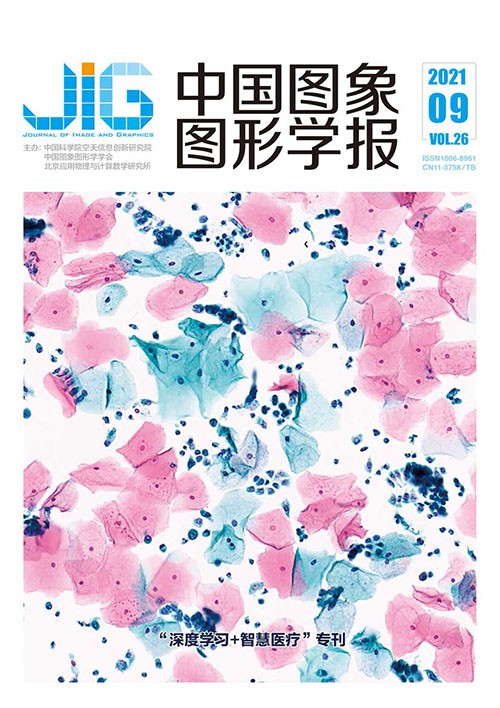
语义拉普拉斯金字塔多中心乳腺肿瘤分割网络
王黎1,2, 曹颖1,2, 郭顺超1,2, 唐雷3, 郐子翔4, 王荣品3, 王丽会1,2(1.贵州大学计算机科学与技术学院, 贵阳 550025;2.贵州省智能医学影像分析与精准诊断重点实验室, 贵阳 550025;3.贵州省人民医院放射科, 贵阳 550002;4.哈尔滨医科大学肿瘤附属医院成像中心, 哈尔滨 150081) 摘 要
目的 乳腺肿瘤分割对乳腺癌的辅助诊疗起着关键作用,但现有研究大多集中在单中心数据的分割上,泛化能力不强,无法应对临床的复杂数据。因此,本文提出一种语义拉普拉斯金字塔网络(semantic Laplacian pyramids network,SLAPNet),实现多中心数据下乳腺肿瘤的准确分割。方法 SLAPNet主要包含高斯金字塔和语义金字塔两个结构,前者负责得到多尺度的图像输入,后者负责提取多尺度的语义特征并使语义特征能在不同尺度间传播。结果 网络使用Dice相似系数(Dice similarity coefficient,DSC)作为优化目标。为了验证模型性能,采用多中心数据进行测试,与AttentionUNet、PSPNet (pyramid scene parsing network)、UNet 3+、MSDNet (multiscale dual attention network)、PyConvUNet (pyramid convolutional network)等深度学习模型进行对比,并利用DSC和Jaccard系数(Jaccard coefficient,JC)等指标进行定量分析。使用内部数据集测试时,本文模型乳腺肿瘤分割的DSC为0.826;使用公开数据集测试时,DSC为0.774,比PyConvUNet提高了约1.3%,比PSPNet和UNet3+提高了约1.5%。结论 本文提出的语义拉普拉斯金字塔网络,通过结合多尺度和多级别的语义特征,可以在多中心数据上准确实现乳腺癌肿瘤的自动分割。
关键词
Semantic Laplacian pyramids network for multicenter breast tumor segmentation
Wang Li1,2, Cao Ying1,2, Guo Shunchao1,2, Tang Lei3, Kuai Zixiang4, Wang Rongpin3, Wang Lihui1,2(1.School of Computer Science and Technology, Guizhou University, Guiyang 550025, China;2.Key Laboratory of Intelligent Medical Image Analysis and Precise Diagnosis of Guizhou Province, Guiyang 550025, China;3.Department of Radiology, Guizhou Provincial People's Hospital, Guiyang 550002, China;4.Imaging Center, Harbin Medical University Cancer Hospital, Harbin 150081, China) Abstract
Objective Accurate diagnosis and early prognosis of breast cancer can increase the survival rates of breast cancer patients. In clinical applications, the process of breast cancer treatment often contains neoadjuvant chemotherapy (NAC) which attempts to reduce tumor size and increase the chance of breast-conserving surgery. However, some patients do not respond positively to NAC and do not show a pathologically complete response. For these patients, NAC is time consuming and highly risky. Therefore, exploring an efficient method for precisely predicting NAC response is essential. A potential scheme is to use medical imaging techniques, such as magnetic resonance imaging in building a computer-assisted diagnosis (CAD) system for predicting NAC response. Most existing CAD methods focus on tumor features, which are highly related to region of interest (ROI) segmentations. At present, breast tumor is segmented manually, and this method cannot satisfy real-time and accurate segmentation requirements. Automatic breast tumor segmentation is a potential way to deal with such issue. Although numerous works about breast tumor segmentation have been proposed and some of them have achieved good results, they mainly focus on the segmentation of single-center datasets. How to improve the generalization ability of a model and ensure its good performance in multicenter datasets is still presents great challenge. To address this problem, we proposed a semantic Laplacian pyramid network (SLAPNet) for segmenting breast tumor with multicenter datasets. Method SLAPNet is composed of Gaussian and semantic pyramids. The Gaussian pyramid is used for creating multilevel inputs to enable the model to notice not only global image features, such as shape and gray-level distribution, but also local image features, such as edges and textures. It is implemented by smoothing and downsampling input images with Gaussian filters, which can denoise the images and blur details. Thus, the characteristics of large structures in the images can be highlighted. By combining these multiscale inputs, SLAPNet is more robust and generalized, so it can handle irregular objects. The semantic pyramid is produced first after UNet extracts deep semantic features with multilevel inputs and then connects adjacent layers to transfer deep semantic features to different layers. This strategy fuses multi-semantic-level and multilevel features to improve model performance. To reduce the influence of class imbalance, we selected Dice loss as our loss function. To validate the superiority of the proposed method, we trained SLAPNet and other state-of-the-art models with multicenter datasets. Finally, the accuracy (ACC), specificity, sensitivity (SEN), Dice similarity coefficient (DSC), precision, and Jaccard coefficient were used in quantitatively analyzing the segmentation results. Result Compared with Attention UNet, DeeplabV3, fully convolutional network(FCN), pyramid scene parsing network(PSPNet), UNet, UNet3+, multiscale dual attention network(MSDNet), and pyramid convolutional network(PyConvUNet), the DSC of our model was the highest, with a value of 0.83 when the model was tested on the dataset acquired from Harbin Medical University Cancer Hospital and a value of 0.77 when the model was tested on the public I-SPY 1(investigation of aerial studies to predict your therapeutic response with imaging and moLecular analysis 1) dataset, increasing by at least 1.3%. The visualization results illustrated that SLAPNet produced a small amount of misclassification and omission in the marginal regions and the segmented edge was better than the segmented edges of the other models. The visualization results of error maps indicated that SLAPNet outperformed other models in breast tumor segmentation. Finally, to further validate the stability of the proposed model, we provided the boxplots of the evaluation metrics, which demonstrated that the DSC, Jaccard coefficient, SEN, and ACC of the proposed model were higher than those of the other models and the three quartiles of the proposed model were closer, indicating that SLAPNet was more stable for multicenter breast tumor segmentation. Conclusion The semantic Laplacian pyramid network proposed in this paper extracted deep semantic features from multilevel inputs and then fused multiscale semantic deep features. This structure guaranteed the high expressive ability of the deep features. We were able to capture more expressive features related to image details by combining multiscale semantic features. Therefore, our proposed model can better distinguish edges and texture features in tumors. The results demonstrated that the pyramid model showed the best performance in multicenter breast cancer tumor segmentation.
Keywords
breast tumor segmentation deep learning semantic pyramids multiscale semantic feature multicenter dataset
|



 中国图象图形学报 │ 京ICP备05080539号-4 │ 本系统由
中国图象图形学报 │ 京ICP备05080539号-4 │ 本系统由